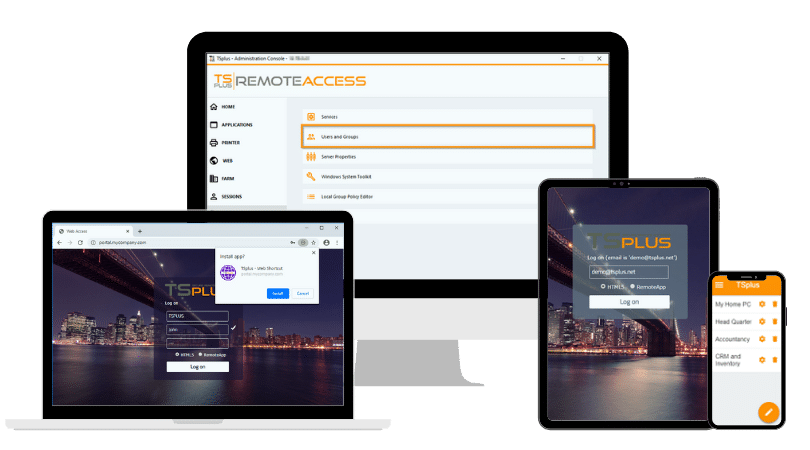What are the RDP Port Numbers and What Are They For?
In this article, we’ll dive into what RDP port numbers are, how they function, common configurations, and best practices for managing and securing these ports.
Would you like to see the site in a different language?
TSPLUS BLOG
The need for seamless access to distant computers has never been greater. This is where RDP Remote Desktop Software comes into play. Whether you are an IT professional managing servers or a business owner supporting remote teams, understanding how RDP works and its practical applications can greatly enhance productivity and security. Discover in this article what RDP Remote Desktop Software is, how it works, its key features, benefits, use cases and security best practices.
)
Remote Desktop Protocol (RDP) is a proprietary protocol developed by Microsoft, designed to allow users to connect to and control remote computers over a network connection. Initially introduced as part of Windows NT 4.0 Terminal Server Edition in 1998, RDP has since become a cornerstone of remote access solutions worldwide. It is an essential technology for IT administrators and businesses that need secure, remote access to servers, workstations, and even cloud-based virtual desktops.
RDP operates on port 3389 by default and uses a secure, encrypted connection to facilitate communication between a client device and a host machine. The protocol efficiently transmits graphical interface data between the two devices, allowing the remote user to view and interact with the host’s desktop environment as if they were physically present.
RDP is a versatile tool with support for various functions, including:
Its integration with Windows makes RDP a popular choice for businesses of all sizes, enabling secure, scalable remote access for IT support, remote work, and server management.
RDP software works by establishing a secure, encrypted connection between a client device and a host machine, allowing users to remotely access and control the host computer. This process relies on a series of critical steps that ensure both functionality and security:
During this process, RDP utilises strong encryption protocols (such as TLS or SSL) to ensure that all data transmitted between the client and host remains confidential and secure.
RDP remote desktop software is favored for its robust feature set, making it suitable for a wide range of IT environments, from small businesses to large enterprises. Its versatility and powerful capabilities allow IT administrators to maintain secure, efficient, and scalable remote access. Here are some of the most important features that make RDP an essential tool for remote connectivity:
These features make RDP remote desktop software an indispensable tool for businesses seeking secure, scalable, and efficient remote access solutions.
Implementing RDP remote desktop software offers numerous advantages for businesses and IT teams, making it a versatile tool for remote management, support, and productivity. Here are the key benefits in greater detail:
RDP enables IT administrators to maintain, monitor, and troubleshoot multiple systems from a single centralized location. Whether managing on-premises servers, cloud-based virtual machines, or remote workstations, IT teams can swiftly resolve technical issues without being physically present. This centralized approach significantly enhances efficiency in multi-site environments, such as retail chains, educational institutions, and distributed offices.
As remote work becomes the norm, RDP provides a secure, seamless way for employees to access their office desktops from home or any location. Employees can use business-critical applications, access internal resources, and work on projects just as they would in the office. This not only ensures business continuity but also enhances employee flexibility and satisfaction.
By reducing the need for on-site support visits, RDP cuts operational expenses. IT support teams can resolve user issues remotely, eliminating travel costs and reducing downtime. Businesses can also save on hardware expenses by centralising computing resources on powerful servers, which users can access remotely.
RDP is equipped with robust security measures, including Network Level Authentication (NLA), which requires users to authenticate before establishing a connection. Additionally, encrypted data transmission using TLS or SSL ensures that sensitive information remains secure, protecting against unauthorized access.
Modern RDP clients are compatible with various operating systems, including Windows, macOS, Linux, Android, and iOS. This cross-platform support ensures that users can connect to remote desktops from virtually any device, enhancing accessibility for both IT administrators and end-users.
RDP remote desktop software is a versatile tool used across various industries, providing secure and efficient remote access solutions. Here are the most common use cases where RDP proves invaluable:
IT teams use RDP to provide remote support, diagnosing and resolving technical issues on user devices without needing to be physically present. Whether fixing software glitches, installing updates, or troubleshooting system errors, RDP allows IT professionals to take full control of user devices, significantly reducing response times and enhancing support efficiency. This capability is especially critical for organizations with distributed teams or clients in different locations.
System administrators leverage RDP to manage and maintain servers hosted in remote data centres. This includes monitoring server health, performing system updates, configuring server settings, and handling security management. By using RDP, administrators can efficiently maintain multiple servers from a centralised location, ensuring optimal performance and security.
As hybrid and remote work become standard, RDP provides employees with secure access to their work computers from home or any location. This enables them to work on critical files, use specialised software, and maintain a consistent work environment, enhancing productivity without sacrificing security.
Teams can leverage RDP for collaborative tasks, such as sharing screens for presentations, conducting live training sessions, or guiding team members through complex tasks. Instructors can take control of participants' screens to demonstrate workflows, troubleshoot problems, or teach new skills. This makes RDP an excellent tool for onboarding new employees or providing ongoing training.
These use cases demonstrate RDP's flexibility, making it a critical tool for businesses seeking to enhance IT support, streamline server management, support remote employees, and foster team collaboration.
While Remote Desktop Protocol (RDP) is a powerful tool for remote access, it is also a common target for cyberattacks if not properly secured. Unauthorized access, brute force attacks, and ransomware are just a few of the threats that can exploit unsecured RDP connections. To ensure your RDP implementation is secure, follow these best practices:
By implementing these best practices, you can significantly enhance the security of your RDP deployment, protecting your systems, data, and users from potential threats.
For businesses seeking a secure, scalable, and user-friendly RDP solution, TSplus Remote Access offers a comprehensive platform designed to enhance remote connectivity. With robust security features, multi-user support, and cross-platform compatibility, TSplus empowers organizations to maintain secure remote access while maximizing productivity. Whether you are looking to support remote workers, manage distributed servers, or provide efficient remote IT support, TSplus has you covered.
Remote Desktop Protocol (RDP) has become an indispensable tool for businesses of all sizes, providing secure and flexible access to remote computers and servers. Whether you are an IT administrator managing remote servers, a support technician assisting users, or an employee accessing your work computer from home, RDP offers a reliable solution for seamless connectivity. However, ensuring that your RDP deployment is secure and optimised is crucial for maintaining performance and protecting sensitive data.

TSplus Remote Access Free Trial
Ultimate Citrix/RDS alternative for desktop/app access. Secure, cost-effective, on-premise/cloud.
Simple, Robust and Affordable Remote Access Solutions for IT professionals.
The Ultimate Toolbox to better Serve your Microsoft RDS Clients.
 Get in touch
Get in touch